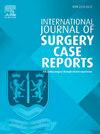颅骨减压术后并发脑疝:系列病例和系统性文献综述。
IF 0.6
Q4 SURGERY
引用次数: 0
摘要
简介:矛盾性脑疝(Paradoxical brain herniation,PBH)是一种罕见的并发症,可能危及颅骨减压切除术后患者的生命。其诊断需要高度怀疑,并结合临床和影像学证据,如中线移位、脑疝和格拉斯哥昏迷量表(GCS)下降。鉴于这种疾病的罕见性和严重性,我们进行了一次全面的文献综述,以确定所有记录在案的诱发因素、临床表现和适当的临床治疗。本综述将作为有效治疗策略的指南:在本报告中,我们记录了三例颅骨减压切除术后创伤后 PBH 病例。患者的诱发因素是腰椎穿刺,其中两例患者在经过 Terendlenburg 复位、补液和选择性颅骨成形术后症状缓解。第三个病例在插入脑室外引流管(EVD)后出现了 PBH。虽然在夹闭 EVD 和补充水分后患者的 GCS 有所改善,但患者最终还是死于脑膜炎:PBH 的主要临床表现通常包括 GCS 下降以及中线移位和脑疝的影像学证据。各种诱发因素都与颅骨减压切除术后的 PBH 有关,包括 CSF 引流、脱水和直立体位,但也有自发性 PBH 的记录。已报道的治疗策略包括补液、特伦德伦堡体位、暂时停止 CSF 引流和颅骨成形术:结论:鉴于 PBH 并不常见,而且有可能被误诊为脑水肿,因此必须考虑每一位在颅骨减压切除术后出现意识水平下降的患者。本文章由计算机程序翻译,如有差异,请以英文原文为准。
Paradoxical brain herniation following decompressive craniectomy: A case series and systematic review of literature
Introduction
Paradoxical brain herniation (PBH) represents a rare and potentially life-threatening complication observed in individuals following decompressive craniectomy. Its diagnosis necessitates a high level of suspicion, combined with clinical and imaging evidence, such as midline shift, herniation, and a decreased Glasgow Coma Scale (GCS). Given the rarity and severity of this condition, we conduct a comprehensive literature review to identify all documented predisposing factors, clinical presentations, and appropriate clinical management. This review will serve as a guide for effective treatment strategies.
Case presentation
In this report, we document three cases of post-traumatic PBH following decompressive craniectomy. The patient's predisposing factor was a lumbar puncture, with two cases resolving after Terendlenburg repositioning, hydration, and elective cranioplasty. The third case developed PBH after external ventricular drainage (EVD) insertion. Although the patient's GCS improved after clamping the EVD and hydration, the patient ultimately succumbed to meningitis.
Clinical discussion
The primary clinical manifestations of PBH often encompass a diminished GCS alongside radiographic evidence of midline shift and brain herniation. Various precipitating factors have been associated with PBH after decompressive craniectomy, including CSF drainage, dehydration, and upright positioning, although instances of spontaneous PBH have been documented. Reported therapeutic strategies encompass rehydration, Trendelenburg positioning, temporary cessation of CSF drainage, and cranioplasty.
Conclusion
Given the infrequency of PBH and the potential for misdiagnosis with brain edema, it is imperative to consider this condition in every patient who experiences a decreased level of consciousness following decompressive craniectomy.
求助全文
通过发布文献求助,成功后即可免费获取论文全文。
去求助
来源期刊
CiteScore
1.10
自引率
0.00%
发文量
1116
审稿时长
46 days

 求助内容:
求助内容: 应助结果提醒方式:
应助结果提醒方式:


